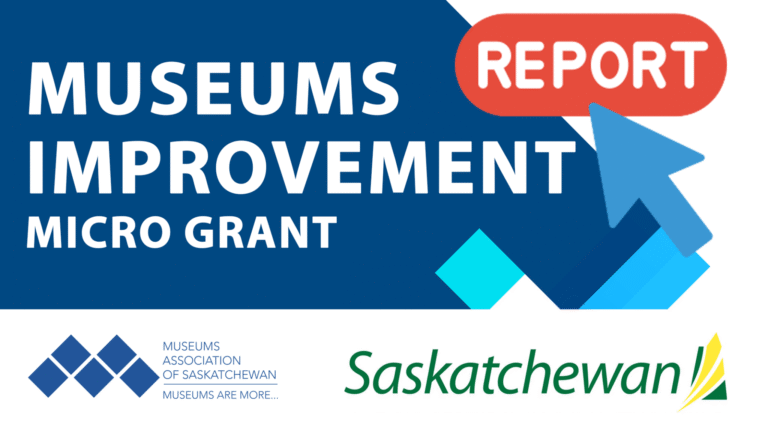By Kathleen Watkin, MAS Advisor
Often when we are conducting inventories and/or looking for artifacts in our storage rooms we come across “Found in Collections artifacts or (FICs). These are artifacts that have missing or no information association with them. We often ask ourselves “Now what?” You have two options: Accession the artifact into the collection or Remove the artifact from the collection. But before we do either option, we must consider the artifact, itself.
What to Consider
Currently, Saskatchewan has no Abandon Property Law in relation to Museums and their collections. Therefore, unless someone can legally provide concreate evidence that the object belongs to them, FICs belong to the museum they were discovered in. FIC artifacts are best addressed on an individual, case-by-case basis
First, you must gather as much information about the FIC artifacts as possible. Ways you can find information about FIC objects include:
- Determining if there is any documentation about the artifact at all; even if it is incomplete
- Are there staff members, volunteers, or docents who have been at the museum for a long time and might remember seeing the object?
- Physical location of the artifact: Near similar artifacts? Located within a group of artifacts which similar accession numbers.
- Search accession files
- Review exhibit catalogs and/or inventories
- Review old newspaper articles, annual reports, or museum newsletters, that reported donations/loans to the museum
- Review old institutional meeting minutes that discussed collections donations/loans
- Sort through old gift and loan agreements
- Compare object description against prior collection inventories
It is Best Practice as you conduct your research to catalogue the artifact and the information you gather about it. Using your museum’s cataloguing system, ensure you record all the artifact’s information including, but not limited to:
- Object Name
- Category
- Description
- Marks/Labels/Inscription
- Materials
- Measurements
- Location
- Condition
- Photograph of the artifact
Now that you have gather as much information as possible about the artifact, you much determine the object’s future status. Are you going to accession the artifact into your collection (Permanent or Educational) or deaccession the artifact (for donation, sale or disposal)?
You need to ask yourself and your board of directors:
- Is the object relevant to your museum’s mission statement or statement of purpose?
- What is the object’s physical condition?
- What is the object’s value, either scientific, scholarly, historic, aesthetic for any institution?
- Is object of First Nations origin?
- Does the object contain materials derived from a threatened or endangered species?
Once considering these fundamental factors, the reconciliation process can begin.
The Reconciliation Process:
Option One: Accessioning
If you decided to accession the FIC artifact into the collection, it should be treated as if it was a regular artifact being accessioned into the collection. If you followed, Best Practices, this will simple mean added an accession number.
When apply an accession number, it needs to be unique and easily identifiable. If your museum uses the three-part numbering system (Year- Sequence Year-Lot Number), then place the numbers 999 in the sequence year slot as an indicator that the object is a FIC. In you are using an Alphabetical Prefix System, use the letter FIC as the prefix.
Examples:
Three Part Number System: 2017-999-01
Alphabetical Prefix System: FIC-2017-01
Once an accession number is given and all documentation is completed, the artifact is now officially part of the museum’s collection.
Option Two: Deaccessioning
Maintaining FIC that do not meet the museum’s mission, are inferior duplicates, are irreparably damaged, or pose a threat to the staff or permanent collection in some way, can be unnecessary and expensive.
If it is determined that disposition or deaccession for sell or gift to another Museum is the best course of action for the FIC artifact, take care to document the objects thoroughly before beginning the process (See Best Practice). Remember, to keep a copy of all the information for internal usage.
The decision might be made to sell or destroy the artifact. However, you need to remember that what is the most appropriate procedure for one object may not be the best for another. For example:
Objects of First Nations origin, or objects containing natural materials may require unique disposition methods.
Objects that could potentially endanger staff or the permanent collection may require more expeditious decisions.
If you are uncertain as to how to proceed, set aside all your FIC objects, making a “don’t know” pile from which you can reconcile artifacts as you have time and as you determine the best course of action for each item.
Conclusion
While finding an undocumented or limited documented artifact in your collection can seem problematic, there are solutions available on how to deal with them. It is in your best interested to investigate the artifact and catalogue it as you find information about it. You and your Board of Trustees will then have all the information you need to make a decision: to Accession or Deaccession.
For More Information, See:
Buck, Rebecca. “Found in Collections.” MRM5: Museum Registration Methods 5th Edition. The AAM Press, 2010. pg. 109-118
Caltin-Legutko, Cinnamon and Stacy Klinger. “Stewardship: Collections and Historical Preservation.” Rowan Altamira, 2012. Pg. 78-81
“Collections Documentation Manual for Saskatchewan Museums.” Museums Association of Saskatchewan.” 2014.
“Found in Collections” Wikipedia. 27 May, 2016. Website: https://en.wikipedia.org/wiki/Found_in_collection



